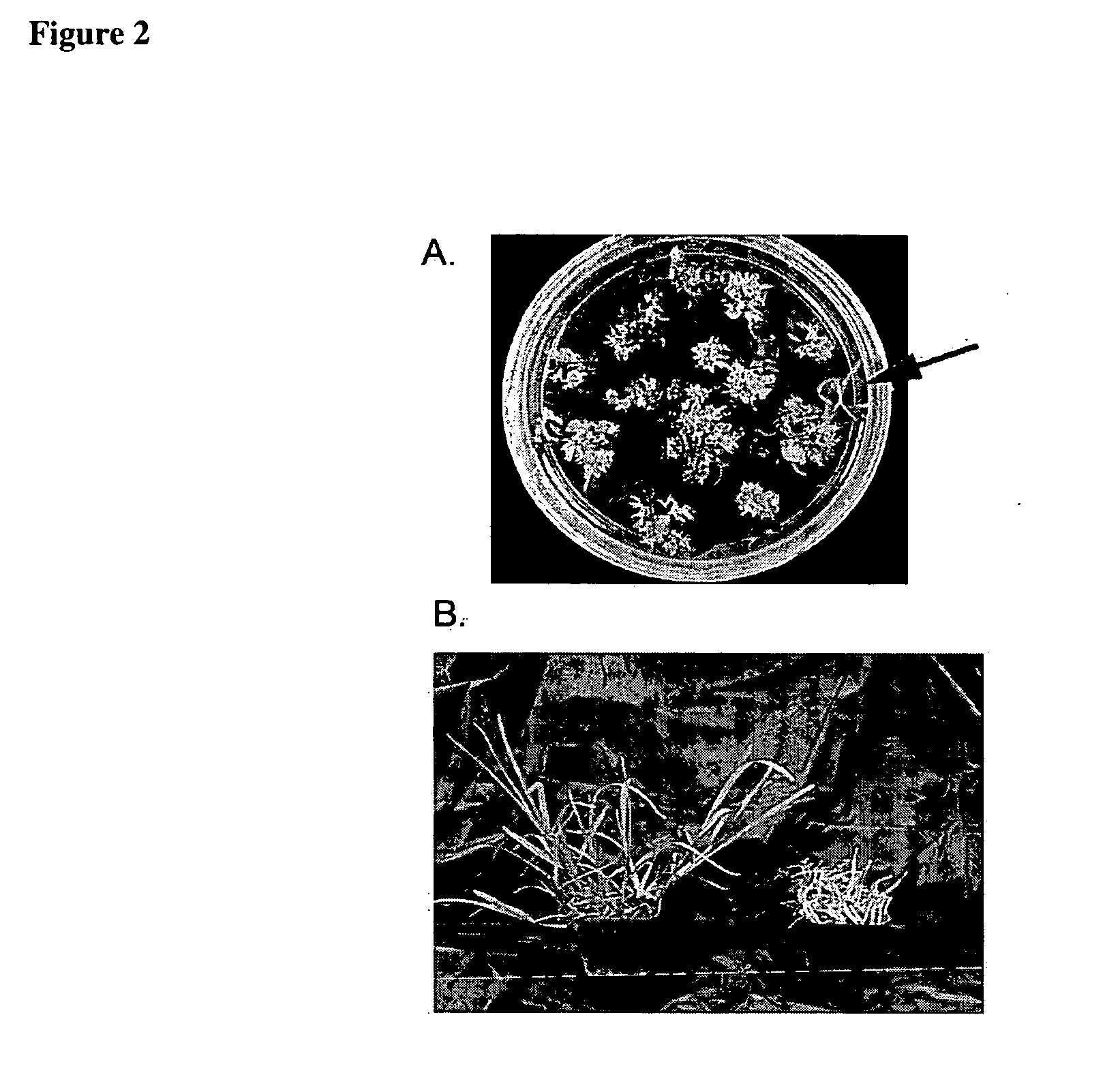Method for regenerating and transforming St. Augustinegrass from embryogenic callus
- Summary
- Abstract
- Description
- Claims
- Application Information
AI Technical Summary
Benefits of technology
Problems solved by technology
Method used
Image
Examples
example 1
Maintenance of Stock Plants and Harvesting of Inflorescence Explants
[0062] Stock plants were maintained in soil (Metro Mix™ 360) in 6″ and 8″ pots under ambient greenhouse conditions. Plants were fertilized weekly with Peters™ CalMag 15-5-15, monthly with Scotts Turfbuilder™ and every three (3) months with Ironite™.
[0063] Inflorescence explants were harvested from established stock plants between the months of December and May. St. Augustinegrass has a rigid flowering season that cannot be artificially altered (that fact has an important association with the longevity of the callus once established). St. Augustinegrass stalks may contain up to 3 inflorescence meristems: a primary (the first to appear) and two secondary on lateral branch points. Typically, the secondary inflorescence is at the smallest size range when harvested, and the primary is the largest. All inflorescence explants were used for culturing, and any could initiate embryogenic callus.
example 2
Preparation of Explants
[0064] Inflorescence explants harvested in Example 1 were stored in resealable plastic bags at 4° C. until they were prepared for culturing. Inflorescence explants stored in this fashion can be stored for at least 10 days and still yield viable embryogenic callus.
[0065] Inflorescence explants used in the experiment were sterilized as follows: excess leaves and stems were trimmed back or removed, leaving at least one outer leaf sheath. Inflorescence explants were then washed with a 5% solution of soap (Sparkleen™) for 5 minutes. Following washing, inflorescence explants were incubated for 2 minutes in 70% ethanol, and 10 minutes in 15% Chlorox™ containing 0.01% detergent (Triton-X or Tween-20), during which they were treated with vacuum pressure 5 minutes to allow the bleach or detergent to infiltrate. Inflorescence explants were then rinsed three (3) times in sterile water, dry blotted, and dissected for culture under a microscope.
[0066] The outer sheath wa...
example 3
Alternative Initiation Media
[0069] Culture media with different composition than F1DG was used to successfully initiate embryogenic calli from St. Augustinegrass inflorescence explants. These media include: MS1DA (same as MS1DG (Table 2) except solidified with 1% agar instead of 0.3% Gelrite), MS1DPCH (Table 3), MS5DPCH (Table 4), MS1DPCH solidified with 1% agar instead of 0.3% Gelrite, and MS5DPCH solidified with 1% agar instead of 0.3% Gelrite.
TABLE 3MS1DPCH medium composition1ComponentWeight (per liter)MS salts1XMS vitamins1XSucrose30gProline1.5gCasein hydrolysate0.5gMES buffer0.5g2,4-dichlorophenoxyacetic acid1.0mgGelrite3.0g
1pH adjusted to 5.8
[0070]
TABLE 4MS5DPCH medium composition1ComponentWeight (per liter)MS salts1XMS vitamins1XSucrose30gProline1.5gCasein hydrolysate0.5gMES buffer0.5g2,4-dichlorophenoxyacetic acid5.0mgGelrite3.0g
1pH adjusted to 5.8
PUM
| Property | Measurement | Unit |
|---|---|---|
| Length | aaaaa | aaaaa |
| Electrical conductance | aaaaa | aaaaa |
| Current | aaaaa | aaaaa |
Abstract
Description
Claims
Application Information
 Login to View More
Login to View More - R&D
- Intellectual Property
- Life Sciences
- Materials
- Tech Scout
- Unparalleled Data Quality
- Higher Quality Content
- 60% Fewer Hallucinations
Browse by: Latest US Patents, China's latest patents, Technical Efficacy Thesaurus, Application Domain, Technology Topic, Popular Technical Reports.
© 2025 PatSnap. All rights reserved.Legal|Privacy policy|Modern Slavery Act Transparency Statement|Sitemap|About US| Contact US: help@patsnap.com



